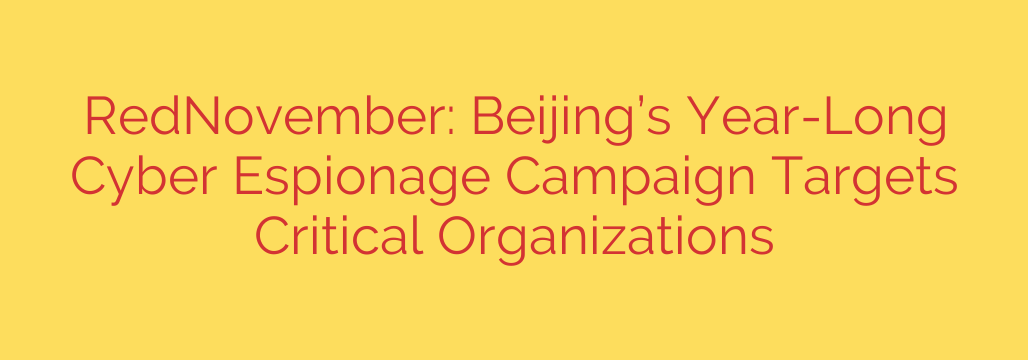
Unmasking RedNovember: Inside the Year-Long Cyber Espionage Campaign Targeting Critical Sectors
A sophisticated, state-sponsored cyber espionage group, dubbed RedNovember, has been linked to a persistent, year-long campaign targeting critical organizations across the globe. This operation is not focused on ransomware or financial gain; its primary objective is long-term intelligence gathering and data theft from high-value government, technology, and telecommunications networks.
The sustained nature of these attacks highlights a significant escalation in espionage efforts, demanding heightened vigilance from security teams worldwide. Understanding the methods and motivations of this threat actor is the first step toward building a resilient defense.
Who is RedNovember?
Security researchers have identified RedNovember as a highly skilled threat actor with significant resources, believed to be operating on behalf of the Chinese government. Unlike cybercriminals who seek quick profits, RedNovember’s mission is strategic. The group focuses on establishing a long-term presence within compromised networks to siphon sensitive data, including intellectual property, government documents, and communications data.
Their patient and methodical approach allows them to remain undetected for extended periods, making them a particularly dangerous adversary for any organization that handles sensitive information.
The Anatomy of an Attack: How RedNovember Operates
The success of the RedNovember campaign relies on a multi-stage attack chain designed for stealth and persistence. The group has demonstrated proficiency in exploiting both technology and human trust to achieve its objectives.
Key tactics include:
- Initial Access via Public-Facing Applications: RedNovember often gains its initial foothold by exploiting known vulnerabilities in public-facing applications, such as web servers and VPNs. This underscores the critical importance of timely patch management and vulnerability scanning.
- Sophisticated Spear-Phishing: In other instances, the group employs targeted spear-phishing emails. These messages are carefully crafted to trick specific employees into executing malicious attachments or clicking on compromised links, thereby deploying initial-stage malware.
- Living-Off-the-Land Techniques: Once inside a network, RedNovember minimizes its footprint by using legitimate system administration tools and built-in operating system functions to move laterally. This “living-off-the-land” approach makes their activity extremely difficult to distinguish from normal network traffic, allowing them to evade many traditional security solutions.
- Data Staging and Exfiltration: Before exfiltrating data, the attackers carefully collect and compress sensitive files in hidden directories. The stolen information is then exfiltrated slowly over encrypted channels to avoid triggering automated alerts that monitor for large, sudden data transfers.
Who Are the Targets? A Focus on Critical Infrastructure
RedNovember has shown a clear preference for targets that hold significant strategic value. The campaign has primarily focused on organizations within the following sectors:
- Telecommunications Providers: Gaining access to telecom networks provides a gateway to vast amounts of communications data and intelligence on a massive scale.
- Government Agencies: Targeting government entities, including diplomatic and military bodies, is a classic espionage objective aimed at acquiring state secrets and policy information.
- Technology and R&D Companies: By stealing intellectual property and research data, the group’s sponsors can gain a significant economic and technological advantage.
The geographic scope of the attacks is global, impacting organizations across Asia, Europe, and North America.
How to Defend Against Advanced Persistent Threats Like RedNovember
Protecting your organization from a well-funded and persistent threat like RedNovember requires a multi-layered, proactive security strategy. Simply reacting to alerts is no longer sufficient.
Follow these actionable steps to bolster your defenses:
Prioritize Vulnerability and Patch Management: The majority of intrusions begin with the exploitation of known flaws. Maintain a strict and timely patching schedule for all software and systems, especially for internet-facing infrastructure like VPNs and web servers.
Implement Strong Multi-Factor Authentication (MFA): Enforce MFA across all critical systems, especially for remote access and administrator accounts. This provides a crucial barrier against attackers using stolen credentials to move laterally within your network.
Enhance Network Monitoring and Segmentation: Assume a breach is possible. Segment your network to limit an attacker’s ability to move from less sensitive systems to critical data repositories. Continuously monitor network traffic for anomalous behavior, such as unusual use of administrative tools or data transfers to unknown external destinations.
Conduct Regular Employee Security Training: Your employees are a critical line of defense. Train them to recognize and report sophisticated phishing attempts. Fostering a security-aware culture can prevent an initial compromise from ever occurring.
Develop and Test an Incident Response Plan: Have a clear, actionable plan for what to do in the event of a breach. Regularly test this plan through tabletop exercises to ensure your team can respond quickly and effectively to contain a threat and minimize damage.
The rise of state-sponsored groups like RedNovember is a stark reminder that the cyber threat landscape is constantly evolving. A proactive and defense-in-depth security posture is the only reliable way to protect your organization’s most valuable assets.
Source: https://go.theregister.com/feed/www.theregister.com/2025/09/27/rednovember_chinese_espionage/








